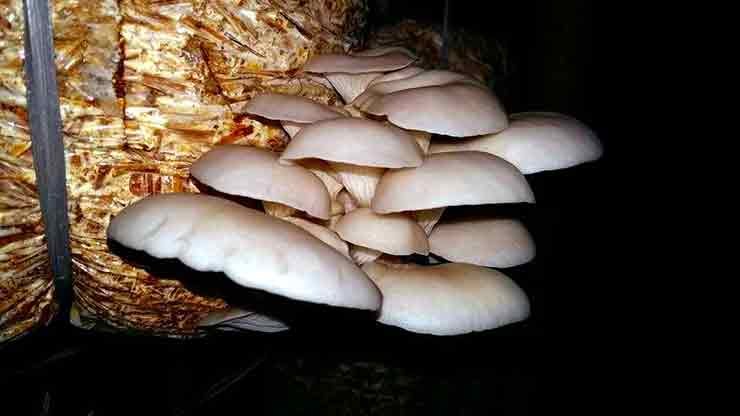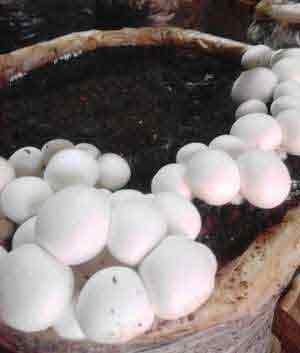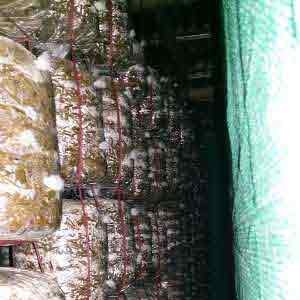Mushroom farming in India is one of the most profitable agribusiness that can be started with minimum investment and space. Mushroom farming in India is growing steadily as an alternative source of income. Here is the complete guidance on paddy straw mushroom, oyster mushroom and button mushroom cultivation in India.
Mushroom cultivation has been in practice since ancient times. Globally, China, Italy, U. S. and Netherlands are the top producers of mushrooms. In India, Uttar Pradesh is the leading producer of mushrooms followed by Tripura and Kerala. Edible mushrooms have tremendous nutritional and medicinal value. Hence they are of significance in domestic and international market.
Mushroom Cultivation Process
Mushroom cultivation requires very low care and investment. There are three types of mushrooms in India which has market demands. Process of growing mushroom is different for each types.

Types of Mushrooms in India
Button mushroom, straw mushroom and oyster mushroom are the three major types of mushrooms in India used for cultivation. Paddy straw mushrooms can grow in temperatures ranging from 35⁰ to 40⁰C. Button mushrooms grow during winter. Oyster mushrooms are grown in the northern plains. All the three mushrooms of commercial importance are grown by different techniques. They are grown on special beds called compost beds. Learn how to cultivate mushroom of each types.
Button Mushroom Cultivation
Making Compost

The first step for growing mushrooms is composting which is done in the open. Compost yard for button mushroom cultivation is prepared on clean, raised platforms made of concrete. They must be raised so that the run-off water does not get accumulated at the heap. Although the composting is done in the open, they must be covered to protect from rain. Compost prepared is of two types, viz. natural and synthetic compost. The compost is prepared in trays of dimensions 100 X 50 X 15 cm.
Synthetic Compost for Mushroom Farming
The ingredients for synthetic compost are wheat straw, bran (rice or wheat), urea, gypsum, calcium ammonium nitrate or ammonium sulphate. The straw must be chopped to 8-20 cm. in length. It is spread uniformly to form a thin layer on the composting yard. The straw is then drenched thoroughly by sprinkling water. The next step is to mix all other ingredients like gypsum, urea, bran, calcium nitrate with the wet straw and heap them into a pile. The piling can be done by hand or with a stick. Take care not to compactly compress the straw although it should be compressed firmly. The pile must be turned regularly as per the following schedule:
| No. of Turns | Days | Additional Ingredients |
|---|---|---|
| 1st Turn | 4th day | Molasses diluted in 20 times water or chicken manure (optional) |
| 2nd turn | 8th day | Nil |
| 3rd turn | 12th day | 10 Kg Gypsum |
| 4th turn | 16th day | 10 Kg Gypsum |
| Final Turn | 20th day | 10mL malathion in 5L water |
During every turn, ensure to drench the heap by sprinkling water so as to make up for the water lost due to evaporation.
Natural Compost for Mushroom Farming
Horse dung, wheat straw, poultry manure and gypsum are the ingredients. Wheat straw must be chopped finely. Horse dung must not be mixed with that of other animals. In addition, it must be preferably freshly collected and not exposed to rain. Once the ingredients are mixed, they are uniformly spread on the composting yard. Water is sprinkled on the spread surface to wet the straws sufficiently. It is heaped and turned like that for synthetic manure. Owing to fermentation, the temperature of the heap increases and it gives an odor due to ammonia escaping. This is an indication that the compost has opened. The heap is turned every 3 days and sprinkled with water. During the 3rd and 4th turning, 25 Kg gypsum to per ton of compost is added. 10mL malathion to 5L water is sprayed in to the heap during the final turning.
Filling the Compost into Trays
The ready compost is dark brown in color and has no odor. It smells like fresh hay with a nearly neutral or neutral pH. While filling the compost into trays, it must be neither too wet nor too dry. In case the compost is dry then sprinkle a few drops of water. If too wet, then allow some water to evaporate. When the compost has the right amount of water, a few drops of water would ooze out when a small amount of the compost is pressed between the palms. The size of the trays for spreading the compost can be as per convenience. However, it must be 15-18 cm deep. The trays must be made of soft wood. They are provided with pegs so that when the trays are stacked one above the other, there is sufficient air gap. The trays must be filled with compost to the brim and levelled on the surface.
Spawning
The process of sowing the mushroom mycelium into the beds is called spawning. The spawns are obtained from certified national laboratories at nominal cost. Spawning can be done in two ways- either scattering the compost on the bed surface in the tray or mix the grain spawn with compost before filling the trays. After spawning the trays are covered with old newspaper sheets. The sheet surface is then sprinkled with water to maintain moisture and humidity. The trays maybe stacked one above the other with spacing of 15-20 cm between 2 trays. There should be a head space of at least one meter between the topmost tray and the ceiling.
Temperature and Other Conditions
The room temperature must be maintained at 25⁰C. Humidity and moisture level must be maintained by sprinkling water on the walls and the floor of the room. During the period of spawn run, there should be no fresh air entering the room. Hence, it must be kept closed. On an average the spawn run lasts for 12-15 days although it may take longer if the temperature is lower.
Casing
The spawn run is complete when there is white cottony growth. The surface of the compost is then covered with casing soil upto 3cm thickness. Casing soil is prepared by mixing finely crushed and sieved, rotten cow dung with the garden soil. The pH must be on the alkaline side (at least 7.4). Once prepared, the casing soil must be sterilized to kill the pests, nematodes, insects and other molds. Sterilization is done by treating it with formalin solution or by steaming. Once the casing soil is spread on the compost the temperature is maintained at 25⁰C for 72 hours and then lowered to 18⁰C. Casing stage needs a lot of fresh air. Hence the room must have adequate ventilation facilities during the casing stage.
Sterilizing Casing Soil Using Formalin
For sterilization of one cubic metre casing soil using formalin, half a litre of formalin in 10 litre water is sufficient. The soil is spread over a plastic sheet and sprinkled with formalin. It is then heaped, covered with another plastic sheet and left to stand for 2 days. After 2 days, it is turned frequently for a week. The idea behind turning is to remove the traces of formalin. Once the casing soil is free of all traces, there would be no smell of formalin left behind.
Cropping
15 to 20 days after casing, pinheads start becoming visible. White colored, small-sized buttons develop within 5-6 days of this stage. Mushrooms are ready for harvest when the caps are sitting tight on the short stem. If they are allowed to stay longer on the stem then the cap may open like an umbrella. Opened button mushrooms are considered to be inferior in quality.
Harvesting
While harvesting, the cap must be twisted off gently. For this, it is held gently with the forefingers, pressed against the soil and then twisted off. The base of the stalk wherein mycelial threads and soil particles cling must be chopped off. Some farmers harvest button mushrooms by chopping them at the soil level.
Average Yield
The average production of button mushroom is 3-4 Kg per tray. In favorable conditions the yield can go upto 6 Kgs as well.
Storage
Once harvested, the mushrooms must be consumed fresh. However, it can stay fresh if stored in refrigerator for upto a maximum of one week. While storing in fridge it is advisable to keep them wrapped in moist paper towel.
Paddy Straw Mushroom Cultivation
Paddy straw or ‘Chinese Mushroom’ is grown in South Eastern parts of Asia. It is dark in color and one of the most popular ones owing to the taste. Unlike button mushrooms, they are grown on raised platforms under shade or in well-ventilated rooms.
Spawning
As the name suggests, these mushrooms are spawned on chopped, soaked paddy straws(See, paddy cultivation guide). Sometimes they are spawned on cereal grains or millets. When they are spawned on paddy straw, they are called straw spawn and when spawned on cereal grains, they are called grain spawn. They are available at certified and government centers at a nominal cost. One bottle of spawn is usually sufficient for one bed.
Preparing the Straw
In India, the mushroom of this variety is grown on paddy straw. Well dried, long straws are tied together in bundles of 8-10 cm in diameter. They are then cut to uniform length of 70-80 cm and soaked in water for 12-16 hours. Excess water is then allowed to drain off later.
Preparing the Bed
Since the mushrooms must be cultivated on raised platforms, foundations made of bricks and soil must be raised. Its size must be slightly larger than the bedding and must be strong enough to hold the weight of the bed. A bamboo frame of the size of the foundation is placed on top of the foundation. Four bundles from the soaked straw is placed on the frame. Another four bundles are placed but with the loose ends in the opposite direction. These eight bundles together make up the first layer of bedding. About 12 cm away from the first layer, the grain spawn is scattered. In case of straw spawn, small pieces of the size of thumb is planted 10-15 cm away from the edges and 4-6 cm deep. Powdered gram or wheat/rice bran is dusted all over the spawn. A second and third of layer of 8 straw bundles are placed on the first layer and spawned again after every layer. The last fourth layer of straw bundles is placed and lightly pressed. Then the whole bed is covered with a transparent plastic sheet. However care must be taken to ensure that the sheet is not in contact with the bed.
Taking Care of the Bed
After covering the straw with plastic sheet, it is left untouched for a week. It takes approximately a week’s time at 35⁰C for the mycelium to permeate the straw thoroughly. Sprinkle the surface of the bed with water once a day if dryness is noticed.
Mushrooming
Generally, mushrooms begin to grow within 10-15 days of spawning. They continue to grow for the next ten days. Once the volva erupts and the mushroom inside is exposed the crop is ready for harvest. These mushrooms being very delicate have a very short shelf life. They must be consumed fresh. If refrigerated, they can be stored only for a maximum of 3 days.
Yield
The yield of this mushroom variety is about 2.5 Kg per bed.
Oyster Mushroom Cultivation
This type of mushroom is grown where the climatic conditions are not favorable for button mushrooms. In addition, it is the simplest to grow and most delicious to eat. Being very low in fat content it is recommended for controlling obesity and patients suffering from diabetes, blood pressure, etc.
Growing Material
Unlike button and paddy mushrooms, this type of mushroom can be grown on farm wastes high in cellulosic content like cotton waste, banana pseudostems, cereal straws, etc. However, the most commonly used substrate is paddy straw.
Growth Techniques
There are two types of growth techniques followed in oyster mushroom cultivation.
1. Polythene Bags

The paddy straw is chopped into small pieces of 5 cm length, soaked in water for eight hours and the water is squeezed out. The paddy is placed in polythene bags that are 45 cm in length and 30 cm in diameter perforated with holes. About 200 grams of grain spawn is mixed 5-6 Kg of straw in these polythene bags. The spawning is done upto 2/3rd of the bags and the mouth is tied. The bags are then placed in shelves in the growing room having a temperature of 24-26 ⁰C and relative humidity of 85%.
2. Rectangular Blocks
Bottomless wooden trays of 50 X 33 X 15 cm in dimensions are needed for this purpose. A transparent polythene sheet is spread on the bottom of the tray such that it becomes the bottom of the tray as well as covers it from the sides on the inner side. The loose edges hang out of the tray. The wet, chopped paddy straw is filled in the tray to form a thick layer of 5 cm and the spawn is scattered uniformly. Lay another 2 layers of straw and repeat spawning after every layer. A last layer of straw is added and compressed firmly. About 200 grams of spawn is sufficient for 2 blocks. The loose ends are folded over the straw block and tied with a string.
Spawn Run
The spawn run under ideal conditions get completed in 10-12 days. Once complete, the cottony white mycelial growth permeates through the straw. This makes the straw compact and it does not split while being handled. The polythene cover is cut and the sheets are untied at this stage. The bags are removed and the straw bundles look like a neat cylinder. The cylinders are then arranged on the shelves and watered twice a day to maintain moisture.
Mushrooming
The first set of mushroom appears after 20 days of spawning. Further 2-3 flushes appear within a time interval of one week. They are harvested once the cap folds.
Harvesting and Storage
Harvesting of mushroom is done by cutting it with a sharp knife or twisting it off with the fingers. They are best consumed fresh. However they can also be dried under a mechanical drier or under the sun and packed in polythene bags.
Yield
1 Kg of oyster mushrooms can be obtained from 5-6 Kg of wet straw.
Conclusion
It can be safely said that mushroom farming in India is a bright field with good prospects for an upcoming farmer. This is especially because mushrooms need minimum care, investment and technology. Even, one can start mushroom cultivation at home in India. Mushroom farming however gives very good returns as compared to the efforts out in. But, you must check the market before large scale production.
Reference

Good & Informative.
Thank you, stay connected.
I want to start mashroom farming. Please tell me centers we can get training.
WHAT ABOUT MARKETING OR SELLING ? PLS MENTION
Mashroom mein fungicide kya use kare
Mushroom cultivation, Now a days is a major business for import and export of other countries, in this business we have to make proud to be a framer………………………………!!!!!!!!!!!!!!!!!!!!!!!!!!!!
Send me information in marathi …plz
You may use Google translator.
Where can I buy formalin?
Formalin is available online and local drug stores.
Could you please provide your email address so I call and ask my questions about Mashroom farming.
We shall contact you once we get started the primary consultancy service.
Donot recommend formalin a hasadious chemical. Suggest stream sterilizing .
IVR.Ravi
Yes, stream sterilization is required for organic mushroom farming. Thanks for your reply.
I want to farming mushroom agriculture so pls where we collect this beeg and plans
So kindly request you to sent me your address
I want to start to grow mushroom
श्रीमान जी,
मैं जीवन सिंह मुरादाबाद शहर का निवासी हूँ, मुझे मशरूम की खेती से सम्बन्धित सम्पूर्ण जानकारी चाहिए।
मशरूम की खेती कैसे की जा सकती है, कितनी जगह में कितनी लागत से कितना लाभ लिया जा सकता है।
अतः आपसे अनुरोध है कि उपयुक्त जानकारी देने की कृपा करें।
जीवन सिंह
Hi sir
.Can I grow mushrooms .because we are staying in Karnataka. I want to cultivate button mushrooms pls you would be suggest me.
Total expense for starting mushroom business
I was looking for a source of shiitake and oyster mushroom spawns in India .
Can you sujjest any suitable sources .
Thanks
I’m Famer I very happy look this
I want start mushroom cultivation I’m from kashmir
I have 203 kanks land hope u will best guide me help me
I PRESIDENT OF 🇮🇳PULWAMA VEGETABLE
FARMERS UNION
किन जगहों पर मशरूम उगाए जा सकते हैं?
is a project report available for modern mushroom farming